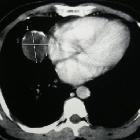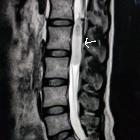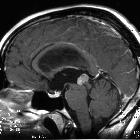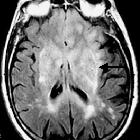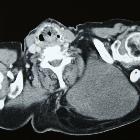WHO classification of CNS tumors
The WHO classification of CNS tumors is the most widely accepted system for classifying CNS tumors and was based on the histological characteristics of the tumor. Although the most recent version of the 'blue book' is the 4edition from 2007, an update has been released in 2016 , which should be considered a replacement for the earlier version.
This 2016 update has, for the first time, included molecular parameters into the diagnostic schema, and in fact, has elevated them in some instances above histological features .
The 5th edition should become available towards the end of 2020 and incorporates some important changes to diffuse gliomas and glioblastoma as outlined in cIMPACT recommendations for the classification of diffuse gliomas 2020 .
This is a fairly dry article, primarily for reference. For more readable versions, see the article on brain tumors and brain tumors in infancy for general discussion of these topics.
Main changes since previous (2007) version
The most recent update (2016) has significantly changed the classification of a number of tumor families, introducing a greater reliance on molecular markers. The most notable changes involve diffuse gliomas, in which IDH status (mutated vs. wildtype) and 1p19q co-deletion (for oligodendrogliomas) have risen to prominence. Importantly if histological phenotype and genotype are not-concordant (e.g. looks like diffuse astrocytoma but is 1p19q co-deleted, ATRX-wildtype) then genotype wins, and it is used to determine diagnosis .
Medulloblastomas have also been divided into distinct molecular subgroups.
Another change is the combining of solitary fibrous tumors of the dura with hemangiopericytoma, which although appearing very different on imaging seem now to be manifestations of the same tumor.
Structure
Despite a move towards molecular markers for some entities, the classification continues to be organized according to the cell of origin (e.g. ependymal tumors) or anatomical origin (e.g. tumors of the sellar region).
For entities that now incorporate molecular markers into their definition (e.g. oligodendroglioma IDH-mutant, 1p19q co-deleted) it is recognized that such markers are not always available or identified. In such cases, a 'not otherwise specified (NOS)' option is available (e.g. oligodendroglioma NOS).
Classification
- NOS: not otherwise specified
- four digit code: is from the International Classification of Disease for Oncology (ICD-O)
- /: the number after the slash (/) refers to biological behavior, not WHO Grade
- *: refers to a 'new' tumor in the classification
- italics: refers to a provisional inclusion
Diffuse astrocytic and oligodendroglial tumors
- WHO grade II
- diffuse astrocytoma
- IDH-mutant - 9400/3
- gemistocytic astrocytoma - 9411/3
- IDH-wildtype - 9400/3
- NOS - 9400/3
- IDH-mutant - 9400/3
- oligoastrocytoma NOS - 9382/3
- oligodendroglioma - 9450/3
- IDH-mutant, 1p19q co-deleted
- oligodendroglioma NOS
- diffuse astrocytoma
- WHO grade III
- anaplastic astrocytoma - 9401/3
- IDH-mutant
- IDH-wildtype
- NOS
- anaplastic oligoastrocytoma NOS - 9382/3
- anaplastic oligodendroglioma - 9451/3
- IDH-mutant, 1p19q co-deleted
- anaplastic oligodendroglioma NOS
- anaplastic astrocytoma - 9401/3
- WHO grade IV
- glioblastoma
- IDH wildtype - 9440/3
- giant cell glioblastoma - 9441/3
- gliosarcoma 9442/3
- epithelioid glioblastoma - 9440/3
- IDH mutant - 9440/3 *
- NOS - 9440/3
- IDH wildtype - 9440/3
- glioblastoma
- diffuse midline glioma, H3K27M-mutant *
Other astrocytic tumors
- WHO grade I
- pilocytic astrocytoma 9421/11 - WHO grade I
- subependymal giant cell astrocytoma 9384/1 - WHO grade I
- WHO grade II
- pilomyxoid astrocytoma 9425/3
- pleomorphic xanthoastrocytoma 9424/3 - WHO grade II
- WHO grade III
- anaplastic pleomorphic xanthoastrocytoma 9424/3 - WHO grade III
Ependymal tumors
- WHO grade I
- subependymoma - 9383/1
- myxopapillary ependymoma - 9394/1
- WHO grade II
- ependymoma - 9391/3
- papillary ependymoma
- clear cell ependymoma
- tanycytic ependymoma
- RELA fusion-positive - 9396/3 *
- ependymoma - 9391/3
- WHO grade III
- anaplastic ependymoma - 9392/3
Other gliomas
- WHO grade I
- angiocentric glioma - 9431/1
- angiocentric glioma - 9431/1
- WHO grade II
- WHO grade not yet assigned
- astroblastoma - 9430/3
Choroid plexus tumors
- WHO grade I
- choroid plexus papilloma - 9390/0
- choroid plexus papilloma - 9390/0
- WHO grade II
- atypical choroid plexus papilloma - 9390/1
- atypical choroid plexus papilloma - 9390/1
- WHO grade III
- choroid plexus carcinoma - 9390/3
Neuronal and mixed neuronal-glial tumors
- WHO grade I
- desmoplastic infantile astrocytoma and ganglioglioma - 9412/1
- dysembryoplastic neuroepithelial tumor (DNET) - 9413/0
- dysplastic gangliocytoma of the cerebellum - (Lhermitte-Duclos) - 9493/0
- gangliocytoma - 9492/0
- multinodular and vacuolating neuronal tumors (MVNT) - uncertain class assignment
- ganglioglioma - 9505/1
- papillary glioneuronal tumor - 9509/1
- paraganglioma of the filum terminale - 8680/1
- rosette-forming glioneuronal tumor of the fourth ventricle - 9509/1
- WHO grade II
- central neurocytoma - 9506/1
- extraventricular neurocytoma - 9506/1
- cerebellar liponeurocytoma - 9506/1
- WHO grade III
- anaplastic ganglioglioma - 9505/3
- anaplastic ganglioglioma - 9505/3
- WHO grade unknown
- diffuse leptomeningeal glioneuronal tumor - no IDC-O code *
Tumors of the pineal region
- WHO grade I
- pineocytoma - 9361/1
- pineocytoma - 9361/1
- WHO grade II or III
- WHO grade IV
- pineoblastoma - 9362/3
Embryonal tumors
- WHO grade IV
- medulloblastoma
- genetically defined
- WNT-activated - 9475/3 *
- SHH-activated & TP53-mutant - 9476/3
- medulloblastoma SHH-activated & TP53-wildtype - 9471/3
- group 3 - 9477/3
- group 4 - 9477/3
- histologically defined
- classic - 9470/3
- desmoplastic/nodular - 9471/3
- extensive nodularity - 9471/3
- large cell/anaplastic - 9470/3
- NOS - 9470/3
- genetically defined
- CNS neuroblastoma 9500/3
- CNS ganglioneuroblastoma 9490/3
- embryonal tumors with multilayered rosettes - 9478/3 *
- C19MC-altered
- NOS
- medulloepithelioma 9501/3
- atypical teratoid / rhabdoid tumor 9508/3
- CNS embryonal tumor with rhabdoid features 8508/3
- CNS embryonal tumor, NOS 9473/3
- medulloblastoma
Tumors of cranial and paraspinal nerves
- WHO grade I
- schwannoma (neurilemoma, neurinoma) - 9560/0
- cellular schwannoma
- plexiform schwannoma
- melanotic schwannoma- 9560/1
- neurofibroma - 9540/0
- atypical neurofibroma - 9540/0
- plexiform neurofibroma - 9550/0
- perineurioma 9571/0
- schwannoma (neurilemoma, neurinoma) - 9560/0
- WHO grade II, III or IV
- malignant peripheral nerve sheath tumor (MPNST) - 9540/3
- epithelioid
- with perineural differentiation
- malignant peripheral nerve sheath tumor (MPNST) - 9540/3
Tumors of meningothelial cells
- WHO grade I
- meningioma - 9530/0
- meningothelial meningioma - 9531/0
- fibrous meningioma - 9532/0
- microcystic meningioma - 9530/0
- psammomatous meningioma - 9533/0
- angiomatous meningioma - 9534/0
- secretory meningioma - 9530/0
- metaplastic meningioma - 9530/0
- lymphoplasmacyte-rich meningioma - 9530/0
- WHO grade II
- atypical meningioma - 9539/1
- clear cell meningioma - 9538/1
- chordoid meningioma - 9538/1
- WHO grade III
- anaplastic meningioma (malignant) - 9530/3
- papillary meningioma - 9538/3
- rhabdoid meningioma - 9538/3
Mesenchymal, non-meningothelial tumors
- WHO grade I, II or III
- solitary fibrous tumor of the dura/hemangiopericytoma - 8815/0 /1 /3
- solitary fibrous tumor of the dura/hemangiopericytoma - 8815/0 /1 /3
- WHO grade I
- angiolipoma - 8861/0
- chondroma - 9220/0
- desmoid-type fibromatosis - 8821/1
- hemangioblastoma - 9161/1
- hemangioma - 9120/0
- hibernoma - 8880/0
- leiomyoma - 8890/0
- lipoma - 8850/0
- myofibroblastoma - 8825/0
- osteochondroma - 9210/0
- osteoma 9180/0
- rhabdomyoma - 8900/0
- WHO grade III
- epithelioid hemangioendothelioma - 9133/3
- angiosarcoma - 9120/3
- chondrosarcoma - 9220/3
- Ewing sarcoma / PNET - 9364/3
- fibrosarcoma - 8810/3
- Kaposi sarcoma - 9140/3
- leiomyosarcoma - 8890/3
- liposarcoma (intracranial) - 8850/3
- osteosarcoma - 9180/3
- rhabdomyosarcoma - 8900/3
- undifferentiated pleomorphic sarcoma / malignant fibrous histiocytoma - 8830/3
Melanocytic lesions
- primary melanocytic tumors of the CNS
- meningeal melanocytosis - 8728/0
- meningeal melanocytoma - 8728/1
- meningeal melanomatosis - 8728/3
- meningeal melanoma - 8720/3
Lymphomas
- diffuse large B-cell lymphoma of the CNS - 9680/3
- immunodeficiency-associated CNS lymphomas
- intravascular large B-cell lymphoma - 9712/3
- Low-grade B-cell lymphomas of the CNS
- T-cell and NK/T-cell lymphomas of the CNS
- anaplastic large cell lymphoma
- ALK-positive - 9714/3
- ALK-negative - 9702/3
- MALT lymphoma of the dura - 9699/3
Histiocytic tumors
- Erdheim-Chester disease - 9750/1
- histiocytic sarcoma - 9755/3
- juvenile xanthogranuloma
- Langerhans cell histiocytosis - 9751/3
- Rosai-Dorfman disease
Germ cell tumors
- choriocarcinoma - 9100/3
- embryonal carcinoma - 9070/3
- germinoma - 9064/3
- mixed germ cell tumors - 9085/3
- teratoma
- mature - 9080/0
- immature - 9080/3
- with malignant transformation - 9084/3
- yolk sac tumor - 9071/3
Tumors of the sellar region
- WHO grade I
- craniopharyngioma - 9350/1
- adamantinomatous - 9351/1
- papillary - 9352/1
- granular cell tumor - 9582/0
- pituicytoma - 9432/1
- spindle cell oncocytoma - 8291/0
- craniopharyngioma - 9350/1
Entities removed
The following entities are no longer found in the 2016 WHO classification, last seen in the 2007 version.
- gliomatosis cerebri - 9381/3
- protoplasmic astrocytoma - 9410/3
- fibrillary astrocytoma - 9420/3
- primitive neuroectodermal tumor (PNET) - 9473/3 (now part of ETMR)
- ependymoblastoma - 9392/3 (now part of ETMR)
- cellular variant of ependymoma
Although oligoastrocytomas remain entities, they are now going to be rare, requiring molecularly distinct populations of both components: astrocytes (IDH-mutant, ATRX-mutant, 1p19q-intact) and oligodendroglial cells (IDH-mutant, ATRX-wildtype, 1p19q-co-deleted) .
New entities
The following entities have been introduced in the 2016 WHO classification.
- epithelioid glioblastoma - 9440/3
- diffuse leptomeningeal glioneuronal tumor - no IDC-O code
- diffuse midline glioma, H3K27M-mutant
- embryonal tumor with multilayered rosettes - 9478/3
- ependymoma RELA fusion-positive - 9396/3
- medulloblastoma - WNT - 9475/3
Siehe auch:
- Osteom
- Lipom
- Pilozytisches Astrozytom
- Gliomatosis cerebri
- Glioblastoma multiforme
- kartilaginäre Exostose
- Ependymom
- Hämangiom
- Oligodendrogliom
- Liposarkom
- Gangliogliom
- Schwannom
- Multiples Myelom
- Rhabdomyosarkom
- Pleomorphes Undifferenziertes Sarkom
- Kraniopharyngeom
- Medulloblastom
- Hämangioblastom
- Pleomorphes Xanthoastrozytom
- Angiosarkom
- Pineoblastom
- Leiomyosarkom
- spinal paraganglioma
- maligner peripherer Nervenscheidentumor (MPNST)
- Pineozytom
- Neurofibrom
- Lhermitte-Duclos-Syndrom
- Dysembryoplastischer neuroepithelialer Tumor
- Karzinom des Plexus choroideus
- solitärer fibröser Tumor
- Plexuspapillom
- Malignes Melanom
- Hirntumoren
- intraventrikuläres Neurozytom
- gemistocytic astrocytoma
- Parenchymtumor der Glandula pinealis mit intermediärer Differenzierung
- Subependymom
- Hibernom
- epitheloides Hämangioendotheliom
- subependymales Riesenzellastrozytom
- Gangliozytom
- spinales Ependymom des Filum terminale
- Myelosarkom
- Pituizytom
- Kaposisarkom
- angiocentric glioma
- gliosarcoma
- rosette-forming glioneuronal tumour of the fourth ventricle
- Papillärer Tumor der Pinealisregion
- Hirntumoren bei Kindern
- extraventrikuläres Neurozytom
- diffuses Astrozytom
- Primitiver neuroektodermaler Tumor des ZNS
- atypischer teratoider rhabdoider Tumor
- haemangiopericytoma (CNS)
- Germinom des ZNS
- Oligoastrozytome
- pilomyxoides Astrozytom
- Anaplastisches Ependymom
- intrakranieller Keimzelltumor
- teratoma (CNS)
und weiter:

 Assoziationen und Differentialdiagnosen zu WHO-Klassifikation der Tumoren des zentralen Nervensystems:
Assoziationen und Differentialdiagnosen zu WHO-Klassifikation der Tumoren des zentralen Nervensystems:




